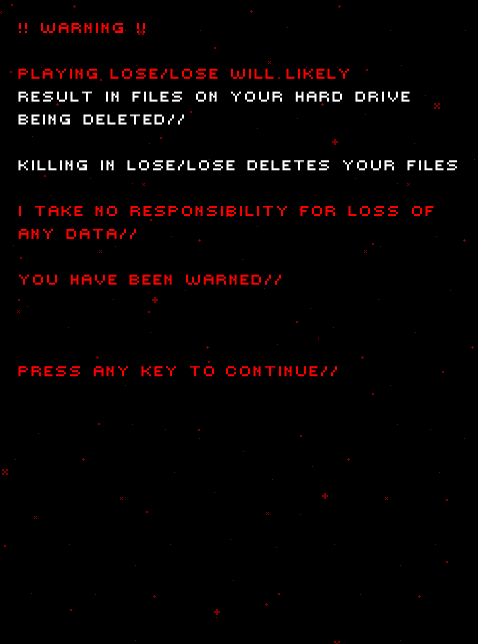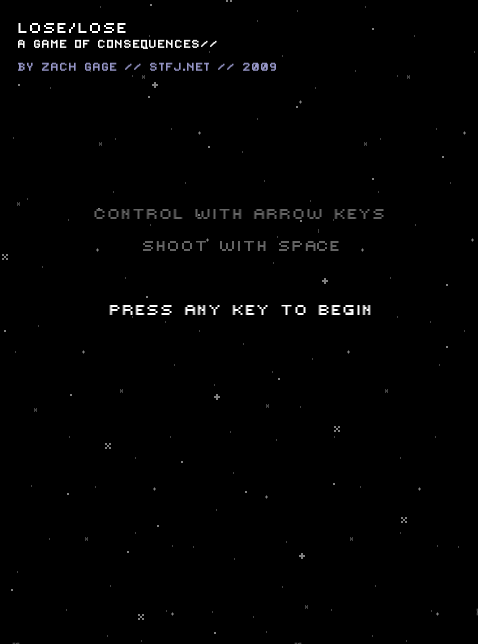Retro Replay Review
Gameplay
At its core, Lose/Lose positions itself as a deceptively straightforward top-down shooter: you pilot a lone spaceship with unlimited ammunition but a single life. Enemies descend in patterns reminiscent of classic arcade titles, challenging your reflexes and spatial awareness. You might anticipate a familiar rhythm of dodging bullets, weaving through swarms, and racking up points—but here’s the catch: each target on screen is linked to a real file on your hard drive.
(HEY YOU!! We hope you enjoy! We try not to run ads. So basically, this is a very expensive hobby running this site. Please consider joining us for updates, forums, and more. Network w/ us to make some cash or friends while retro gaming, and you can win some free retro games for posting. Okay, carry on 👍)
As you blast away, every destroyed enemy permanently wipes its corresponding file from your computer. From arbitrary text documents to essential system libraries, there’s no discrimination or filtering: the game scans your entire home directory and methodically converts each file into a procedurally generated adversary. A simple kill can delete years of work or critical operating components, forcing you to weigh every shot with genuine anxiety.
Compounding the tension is the rule that being hit once ends your game—and then the game deletes itself entirely. This one-shot kill mechanic means that a single mistake not only costs your progress but also erases the application from your system. Such punitive design choices challenge conventional ideas of risk and reward in gameplay, delivering a visceral lesson on consequence that’s as much psychological experiment as it is interactive entertainment.
Graphics
Visually, Lose/Lose embraces a minimalist, retro-inspired aesthetic that channels the look of early computer shooters. Your ship and the file-based foes are rendered in simple vector-like shapes, with a limited color palette that evokes monochrome terminals and vintage arcades. This stark presentation keeps the focus on the stakes of each encounter rather than flashy special effects.
Enemy sprites are differentiated only by color and subtle shape variations until you shoot them and the file extension is revealed. This stripped-down approach heightens suspense: you’re never quite sure whether you’re facing a harmless note or a crucial system file until it’s already too late. The lack of elaborate animations or particle effects is intentional, underscoring the game’s conceptual premise over visual spectacle.
Sound design follows suit with minimal cues—a few beeps and blips accompany each shot and hit. The austere audio landscape amplifies moments of dread, transforming every enemy encounter into a pulse-racing gamble. In this case, the graphics and sounds work in concert to create an atmosphere of cold, sterile tension rather than traditional arcade excitement.
Story
Lose/Lose eschews a conventional narrative in favor of meta-commentary on choice, consequence, and digital mortality. There’s no protagonist to rescue or empire to conquer—your only mission is survival, and the real stakes are hidden in your own file system. The “story” unfolds not through cutscenes or dialogue but through each file you decide to destroy.
The initial warning screen bluntly states that the game will delete files, and you have only two options: never shoot or never play. This stark proclamation serves as the entire backstory, forcing you to confront the ethical dilemma at the heart of the experience. Every decision becomes a reflection on digital ownership and the permanence of data, turning a simple shooter into a provocative thought experiment.
In effect, Lose/Lose’s narrative is written by the player’s actions. Choosing to fire transforms your gameplay into a personal story of loss—whether you obliterate inconsequential notes or vital system files. The unfiltered randomness of file selection underlines the game’s philosophical premise: in an uncontrolled system, every action carries irreversible weight.
Overall Experience
Playing Lose/Lose is more akin to participating in an interactive art installation than traditional gaming. The novelty of risking real files injects a level of authenticity and dread rarely seen in commercial titles. Each session is a high-stakes gamble that blends adrenaline-fueled shooting mechanics with the sobering reality of data destruction.
However, this daring concept comes with significant practical drawbacks. Most players will be unwilling—or simply too terrified—to play on any meaningful directory, effectively limiting the game’s mechanical depth. The inability to target specific files or create safe zones also means that any run can end in catastrophic data loss, which may alienate even the most adventurous gamers.
Ultimately, Lose/Lose is a polarizing experience best suited for those intrigued by its radical statement on digital fragility. It’s not a title you’ll return to for conventional fun, but rather an unsettling demonstration of how games can push boundaries and provoke deeper reflection. If you’re looking for a traditional shooter or worry about losing irreplaceable files, you’ll want to steer clear—yet it remains a compelling artifact for anyone fascinated by the intersection of art, technology, and consequence.
 Retro Replay Retro Replay gaming reviews, news, emulation, geek stuff and more!
Retro Replay Retro Replay gaming reviews, news, emulation, geek stuff and more!





Reviews
There are no reviews yet.